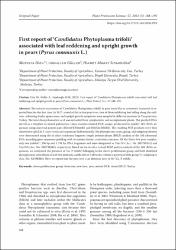| dc.contributor.author | Usta, Mustafa | |
| dc.contributor.author | Güller, Abdullah | |
| dc.contributor.author | Sipahioğlu, Hikmet Murat | |
| dc.date.accessioned | 2021-07-14T19:43:49Z | |
| dc.date.available | 2021-07-14T19:43:49Z | |
| dc.date.issued | 2021 | en_US |
| dc.identifier.citation | Usta, M., Güller, A., & Sipahioğlu, H. M. (2021). First report of'Candidatus Phytoplasma trifolii'associated with leaf reddening and upright growth in pears (Pyrus communis L.). Plant Protection Science, 57(3), 188-195. | en_US |
| dc.identifier.issn | 1212-2580 | en_US |
| dc.identifier.issn | 1805-9341 | en_US |
| dc.identifier.uri | https://doi.org/10.17221/163/2020-PPS | |
| dc.identifier.uri | https://hdl.handle.net/20.500.12899/281 | |
| dc.description.abstract | The natural occurrence of 'Candidatus Phytoplasma trifolii' in pear trees (Pyrus communis Linnaeus) is reported here for the first time. In 2017, a total of thirty-five pear trees, two of them exhibiting leaf rolling along the mid-vein, reddening, bushy appearance, and upright growth symptoms were sampled in different locations in Van province, Turkey. The total deoxyribonucleic acid was extracted from symptomatic and asymptomatic plants. The purified DNA served as a template in nested polymerase chain reaction (nested-PCR) assays, performed to amplify 16S rRNA sequences using universal primer pairs (R16mF2/R16mR1 and R16F2n/R16R2). The resulting PCR products were then cloned into a pGEM T-Easy vector and sequenced bidirectionally. The phytoplasma strain, group, and subgroup identity were determined using the in silico restriction fragment length polymorphism (RFLP) analysis of the 16S ribosomal RNA-encoding gene sequences profiling with seventeen distinct restriction enzymes. Of the thirty-five pear samples, only two yielded 1 256 bp and 1 258 bp DNA fragments and were designated as Van-Pr3 (Acc. No. MH709141) and Van-Pr4 (Acc. No. MH730561), respectively. Based on the in silico virtual RFLP pattern analysis of the 16S rRNA se-quences, we confirmed the presence of 'Ca. P. trifolii' belonging to the clover proliferation group and both identified phytoplasmas were identical with the similarity coefficient of 1.00 to the reference pattern of 16Sr group VI, subgroup A (Acc. No. AY390261). Here we report that the pear tree is an alternate host of the 'Ca. P. trifolii'. | en_US |
| dc.language.iso | en | en_US |
| dc.publisher | Czech Academy of Agricultural Sciences | en_US |
| dc.relation.ispartof | Plant Protection Science | en_US |
| dc.rights | info:eu-repo/semantics/openAccess | en_US |
| dc.subject | Clover proliferation group | en_US |
| dc.subject | Detection | en_US |
| dc.subject | Nested-PCR | en_US |
| dc.subject | New host; Pear | en_US |
| dc.subject | Pear | en_US |
| dc.subject | Virtual RFLP | en_US |
| dc.subject | Turkey | en_US |
| dc.subject.lcc | Pears--Diseases and pests--Identification. | en_US |
| dc.title | First report of 'candidatus phytoplasma trifolii' associated with leaf reddening and upright growth in pears (Pyrus communis l.) | en_US |
| dc.type | Article | en_US |
| dc.authorid | 0000-0002-2304-2794 | en_US |
| dc.department | MTÖ Üniversitesi, Ziraat Fakültesi, Bitki Koruma Bölümü | en_US |
| dc.institutionauthor | Sipahioğlu, Hikmet Murat | |
| dc.identifier.doi | 10.17221/163/2020-PPS | |
| dc.identifier.volume | 57 | en_US |
| dc.identifier.issue | 3 | en_US |
| dc.identifier.startpage | 188 | en_US |
| dc.identifier.endpage | 195 | en_US |
| dc.relation.publicationcategory | Makale - Uluslararası Hakemli Dergi - Kurum Öğretim Elemanı | en_US |
| dc.identifier.scopus | 2-s2.0-85108694486 | en_US |
| dc.identifier.scopusquality | Q3 | en_US |
| dc.identifier.wos | WOS:000692795700003 | en_US |
| dc.identifier.wosquality | Q3 | en_US |
| dc.indekslendigikaynak | Web of Science | en_US |
| dc.indekslendigikaynak | Scopus | en_US |


















